The five acre forest now clothes an ancient migrated dune; it is all sand and therefore dry land. After twenty years of clearing and planting, topsoil is beginning to form where tree debris has been left to rot and return goodness to the ground, and especially at the bottom of slopes to where subsoil water gravitates.
The Dune offers ideal conditions for New Zealand’s native rewarewa, Knightia excelsa, and for the various species of shrub, Pomaderris: they need poor light soils and perfect drainage, and will die if fertilised. Tough native conifers such as totara, Podocarpus totara, and adaptable pioneer woodland species such as akeake, karo, tea tree, Pittosporum and Pseudopanax species all respond well if given sufficient time. Their delicate flowers are a herald of spring.
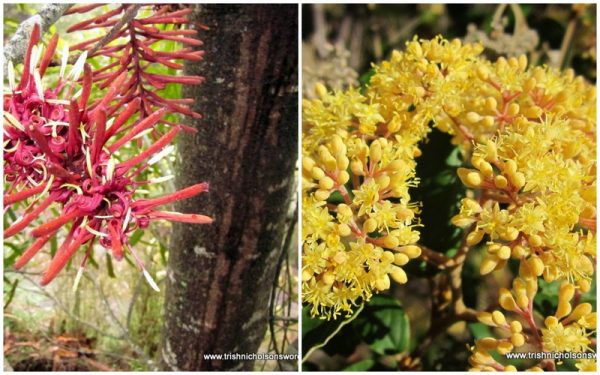
But there are native trees that cannot thrive here because they need damp soils, including the beautiful marble-leaved putaputaweta, Carpodetus serratus. Although pretty much everything needs watering for the first couple of years until they become established, permanent dependence on human intervention for basic resources is not a sustainable future for the five acre forest. I must submit to Nature’s discipline.
I have taken chances in the past in an effort to extend to its limits the diversity of species on the Dune, because one of my aims is to develop a natural source of seed for the depleted environment that surrounds the five acre forest.
Kohekohe, Dysoxylum spectabile, was an unexpected success; all have flowered though some have grown faster than others according to the conditions they experience.
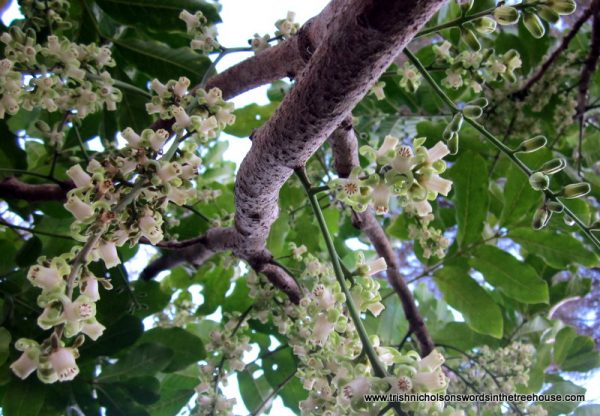
Previous failures include native clematis, puawhananga, C. paniculata, which I planted several times under trees at the bottom of a slope where a narrow strip of flat land holds ground water for longer; each time, they grew a few metres, flowered and died during particularly dry spells.
Near the top of the Dune, under tree shade, groundcovers, Pratia, and Fuschia procumbens, survived for several years and only recently disappeared. Our local climate has become recognisably dryer, and we have suffered two consecutive years of severe drought; pushing the tolerance of plants is increasingly risky.
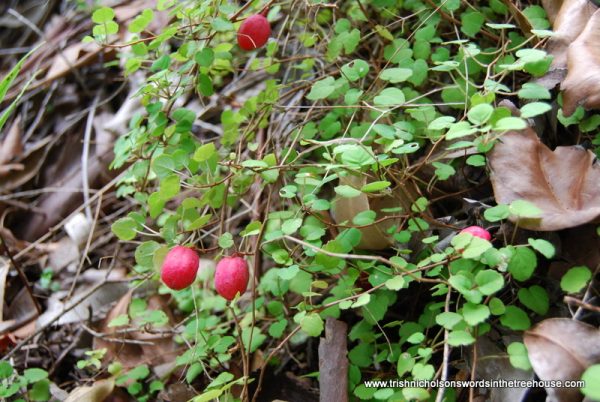
But as the young trees have grown and begun to form a light canopy, there is one place where I can indulge my wish to nurture native plants that need damp conditions – the Round Garden.
In the middle of the five acre forest, on top of the Dune, I set aside a small circular area beside my cottage – and close to a garden tap. I planted native trees around it, and allowed a large banksia to remain because Tūī love the nectar from its flowers. And in the centre of this seclusion is the birdbath where avian frolics bring constant delight.
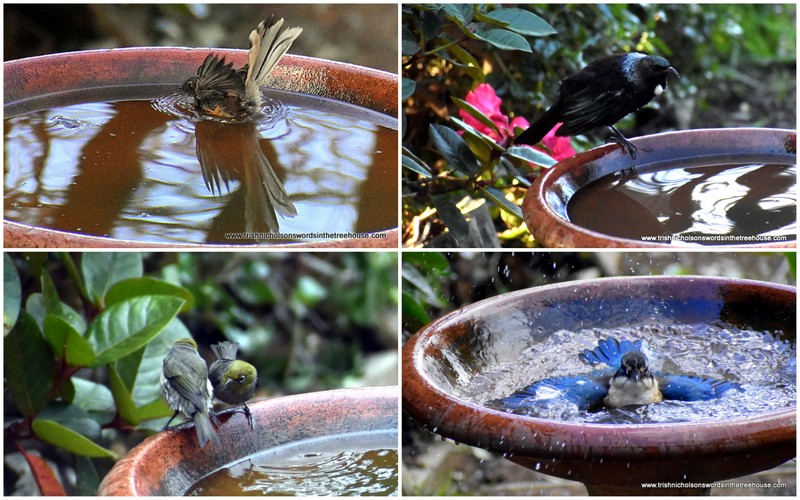
On hot days, the birds are queuing up in the bushes for a bath. Each has its own routine. The kingfisher dives straight from a tree branch, scoots through the water and out the other side a couple of times before standing on the edge to take brief furtive dips. Perhaps the dive is to test the water, or to stake his turn, but I suspect it is for sheer joy. Tūī takes bathing far more seriously. He plunges and wriggles a dozen times and emerges on the rim dripping and bedraggled, the fluffy white pom-poms at this throat reduced to dripping strings. Little white-eyes and fantails generally favour the security of communal bathing. Always watchful, they dip and flutter rapidly, darting back and forth into the bushes. [The Five Acre Forest]
The Round Garden is a special quiet place, an informal memorial to lost family and friends. After several years of experimentation, I found that Vireya rhododendrons and azaleas flourish best, and their bright flowers, staggered throughout the year, are a source of joy. Both need light shade and perfect drainage, but their roots need access to air and moisture and can easily be watered lightly when necessary during summer.
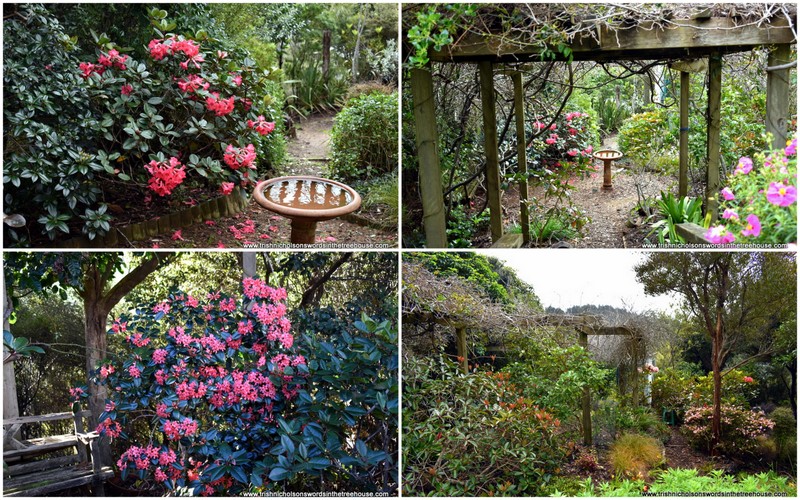
Last year, to re-visit previous failures, I created a damp corner in a shady part of the Round Garden by digging-in a lot of compost, and surrounding it with rotting wood to slow down runoff and, though I depend entirely on rain-water tanks,being a small area, regular watering throughout summer is feasible. Here I have planted miniature tree ferns, Blechnum fraseri, Chatham Island forget-me-not, Myosotidium hortensia, and Pratia in a second attempt to establish this pretty little native member of the lobelia family.
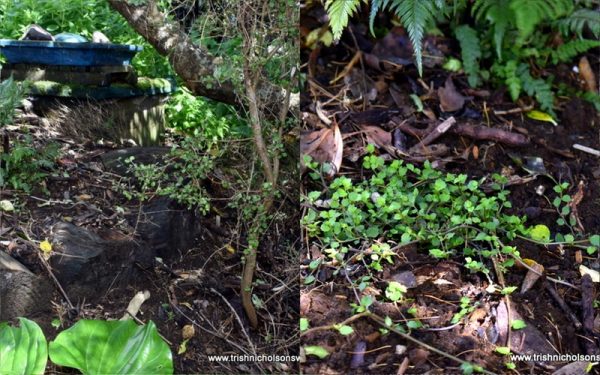
As Fuschia procumbens, the other native ground cover I want to establish, is less demanding of water and more adaptable than Pratia, I planted them beneath the light shade of Vireyas. And the clematis will have another chance too: planted in two places under the surrounding trees – because their roots must be well shaded – where I can keep a close eye on them and where they have plenty of opportunity to climb and scramble.
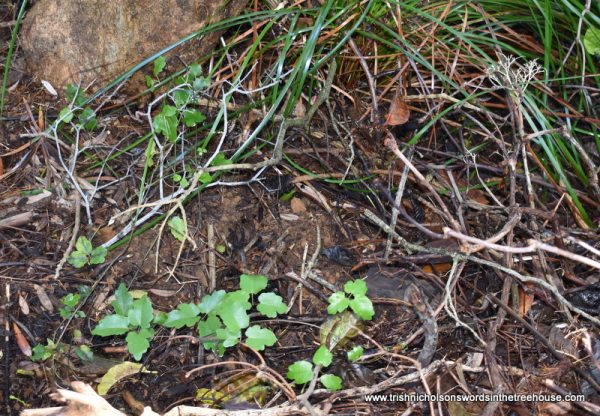
Tree-planting requires immense patience and optimism. Now that the earliest plantings on the Dune are beginning to form a canopy and are more or less self-maintaining – apart from weeding out inevitable gorse and wattle – I need raise only a few plants each year to fill gaps and my work load is lighter. This gives me the opportunity to nurture a few native plants that require more personal attention than I could provide before.
If you have enjoyed this post, please be kind and share it with others, so they can enjoy it too. Thank you.
Trish Nicholson is the author of The Five Acre Forest, a personal tale of tree planting that tells the deep-time story of a New Zealand sand country landscape. Available in bookshops, and online (free worldwide delivery) at Book Depository.
If you would like to know more about the contents of The Five Acre Forest, please see this earlier blog post: Seeds of the Five Acre Forest

You do live a lovely, informed life, Trish! And those birds… terrific.
Hello Ginny, thank you, yes, the number and variety of birds that now live in or visit the Dune is a huge reward for all my efforts.
A lovely post, Trish. What riches you have around you! I’ve just been to the Book Depository link to find your book, but it tells me it’s unavailable. I wonder if that’s because of where I live?
PS the link to the Mases of the Moryons also doesn’t work, I’m afraid.
Hi Val, Masks of the Moryons has not been commercially available for a decade, but I keep it on request from my website for private study. Maybe it’s time I removed these old titles.
No problem, Trish. It’s one of yours I haven’t read, so I thought I’d give it a try.
Hello Val, I’m glad you liked the post. There’s no problem about your location, it’s just that Book Depository sold out the stock they held for the moment. There’s plenty of stock in the warehouse, so it should be available again in a few days.
Ah, I’ll try again soon. Is it the one I read the draft of earlier? I hope so! As regards location, I have found that we have problems getting things due to Brexit. If I want to buy my own books now in the UK, even for other people who live there, I can’t, or I have to pay a stupidly inflated price from a private seller.
What a beautiful environment you have created in the Round Garden, Trish and obviously well used by the birds.
Thank you Chris, yes, the birds make full use if it, and I make full use of the opportunity to watch them from my window 🙂